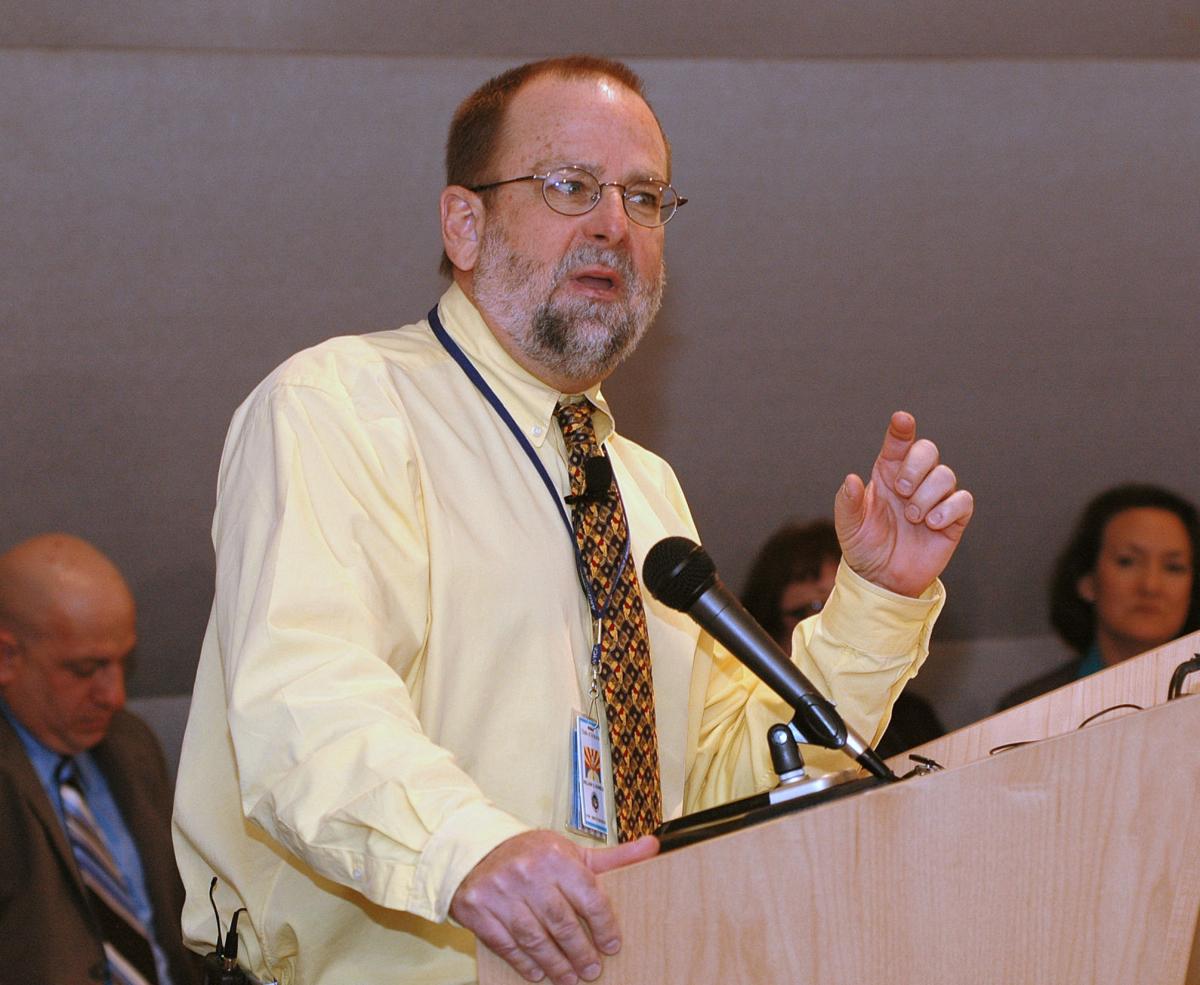PHOENIX – The number of Arizonans hospitalized with positive or suspected cases of COVID-19 shot past 1,000 on Monday, raising questions from the state’s former health chief about whether Gov. Doug Ducey should have abandoned his stay-at-home order.
The figure, a record, comes amid what has been a steady upward trend since the Department of Health Services began tracking the numbers in early April.
It also follows the setting of another record last week, with 635 positive cases reported from tests conducted on May 26.
There is some fluctuation in those daily numbers, with reports sometimes taking days to be filed with the state. And even the Department of Health Services says that illnesses within the past four to seven days may have yet to be reported.
But here, too, there is a general upward trend.
Overall, the state reported 24 new deaths Tuesday, bringing the total for Arizona up to 941, including 191 deaths in Pima County.
And the Biodesign Institute at Arizona State University, which keeps its own records, said there has been a steady increase in the number of new cases.
Using a seven-day average, the institute says the state is generating an average of 519 new cases a day. By contrast, on May 15, when the stay-at-home order expired, the average new cases was 378 a day.
And that move followed Ducey agreeing to allow bars and restaurants to reopen and to ease restrictions on other businesses.
Cause for concern
Will Humble, executive director of the Arizona Public Health Association, told Capitol Media Services the figures give him some concern.
“What it tells me ... is that the stay-at-home order was working, because when it ended, it started popping back up again,” he said.
But Humble, himself a former state health director, said the trend also says something else.
“I’m afraid there’s no seasonal effect, or not a significant one,” he said.
“I would have expected to see a moderating effect because of the really high temperatures over the last two weeks,” Humble explained. “Instead, you see this uptick in cases starting on the 26th which continues today.”
What makes the 26th significant, he said, is that the stay-at-home order ended on May 15.
From there, there’s an incubation period of about a week. And then, Humble said, it can take four to six days for lab tests to come back.
Humble said there are several takeaways from the data, particularly the number of patients in hospitals.
“No. 1 is to keep real good eye on hospital capacity numbers over the next week,” he said.
“Up until now, there’s been a sense of complacency I think, even in my own mind, that we were going to have plenty of hospital capacity,” Humble said. “But when you see the trends since the 26th, which reflects the end of the stay-at-home order, it makes me believe that at some point there might be a threshold where we’re going to be bumping up against ICU bed and inpatient capacity.”
The recent figures from the health department show hospitals overall are using 82% of their inpatient beds and the same percentage of intensive care unit beds.
“We don’t want to end up looking like New York and northern Italy,” Humble said. “I didn’t think that was possible two weeks ago.”
No second thoughts
Humble said there may be another shoe yet to drop.
He cited several high-profile cases where patrons were swarming in and around reopened bars and restaurants over the Memorial Day weekend, virtually none of whom were wearing masks. There also was a crush of people lined up for tubing on the Salt River, also without facial coverings.
“That was about two weeks ago,” Humble said. “This week is the week I’d expect to see numbers popping up because of the behaviors that happened over Memorial Day.”
He acknowledged he is looking at the issue strictly from a public-health perspective. But Humble, who served under both Democrat and Republican governors, acknowledged there’s a political component in the decisions that have to be made.
“This is a decision for elected officials, especially the governor,” he said. “What’s their tolerance level for having an increased number of cases, recognizing that that has a real-life impact in the community and people’s lives, balanced against his concern about GDP and employment, etc.”
Patrick Ptak, the governor’s spokesman, said his boss is having no second thoughts on the decisions he made to ease business and travel restrictions.
“The governor stands by his actions,” he said. Ptak said Ducey’s decisions have been guided by recommendations of public health experts and criteria set by the Centers for Disease Control and Prevention to determine what restrictions can be lifted.
Still, he said, the numbers are no surprise.
“As we continue to increase testing and slowly phase in reopening, we expect to see continued cases of COVID-19,” Ptak said. And he said that, despite the more than 1,000 patients hospitalized with the virus, “our hospitals are well-equipped and have the capacity to ensure anyone who needs health care has access to it.”
A spokeswoman for state health director Cara Christ echoed the comments about the expectation of continued cases of the virus.
“We know COVID-19 is still in our community, and we encourage everyone to take steps to remain healthy, especially those most vulnerable to COVID-19,” said Holly Poynter. She did not answer questions of whether Christ believes the easing of restrictions was a mistake.
"We're tough as saguaros," editorial cartoonist David Fitzsimmons says. He says he saw a video made for the people of Detroit and became inspired to do his own take for Tucson.
Photos for May 29: Tucson gets by during Coronavirus Pandemic
Tucson gets by during coronavirus pandemic
Updated
The iconic Casa Molina bull and matador statue both sport masks on the first full week of the loosening of COVID19 restrictions, May 23, 2020, Tucson, Ariz. The bull previously had a mask on the testicles.
Tucson gets by during coronavirus pandemic
Updated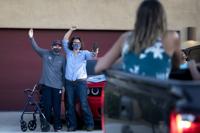
Michelle Leon Cordova, right, mother, and her son Sahuarita High School senior Lino Cordova, whom is fighting cancer, wave at staff members from Diamonds Children Center, friends and the Marana Police Department during a car parade, celebrating Lino's graduation, outside of his home on May 13, 2020 in Sahuarita, Ariz. Cordova stood on the sidewalk while the team from Diamond Children Center, friends and the Marana police department gave Cordova a graduation gar parade. Cordova was given a gift basket with his favorite snacks, gift cards as well as other items he enjoys. The car parade, also, celebrated another graduating senior fighting cancer from Empire High School, Noah Nieto. Nieto, also, received a gift basket with snacks, gift cards and other items Lino enjoys.
Tucson gets by during coronavirus pandemic
Updated
Michelle Leon Cordova, right, mother, brings celebration balloons to a car after staff members from Diamonds Children Center, friends and the Marana Police Department celebrate Sahuarita High School senior Lino Cordova, whom is fighting cancer, graduation with a car parade outside of his home on May 13, 2020 in Sahuarita, Ariz. Cordova stood on the sidewalk while the team from Diamond Children Center, friends and the Marana police department gave Cordova a graduation gar parade. Cordova was given a gift basket with his favorite snacks, gift cards as well as other items he enjoys. The car parade, also, celebrated another graduating senior fighting cancer from Empire High School, Noah Nieto. Nieto, also, received a gift basket with snacks, gift cards and other items Lino enjoys.
Tucson gets by during coronavirus pandemic
Updated
Personnel from Tucson Medical Center line the heliport to watch A-10's from Davis-Monthan Air Force Base's 355th Wing and F-16's from the Arizona Air National Guard's 162nd Wing make a pass over the facility, one leg of an area wide community flyover, May 14, 2020, Tucson, Ariz.
Tucson gets by during coronavirus pandemic
Updated
Nancy Celix-Campos, right, a respitory therapist at Tucson Medical Center, watches the military flyover with her daughters, Giana, 12, and Jazmyn, 8, from Sentinel Peak on May 14, 2020. Two F-16 Fighting Falcons from Arizona Air National GuardÕs 162nd Wing and two A-10 Thunderbolt II's from the 355th Wing, assigned to Davis-Monthan Air Force Base, fly over Tucson area hospitals to honor healthcare personnel and first responders as they are some of the frontline workers dealing with the coronavirus disease (COVID-19) head on. "It's been an exhausting two to three months," says Campos, "it's pretty cool, I like how they're going by each hospital."
Tucson gets by during coronavirus pandemic
Updated
Two F-16 Fighting Falcons from Arizona Air National Guard’s 162nd Wing and two A-10 Thunderbolt II's from the 355th Wing, assigned to Davis-Monthan Air Force Base, fly over Northwest Medical Center north of Tucson on May 14, 2020.
Tucson gets by during coronavirus pandemic
Updated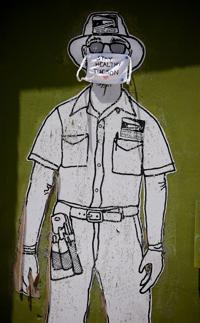
A letter carrier portrait on the Ok Market building, located in the Armory Park neighborhood, is adorned with a face mask on May 18, 2020.
Tucson gets by during coronavirus pandemic
Updated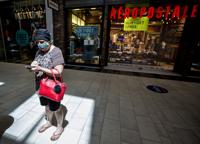
Rosemary Garcia waits for a family member outside of a store at Park Place Mall, 5870 E. Broadway Blvd., in Tucson, Ariz. on May 19, 2020. Malls reopened today under CDC guidelines and Gov. Ducey's new rules for businesses due to the Coronavirus pandemic. Park Place Mall has signs throughout the mall reminding customers to keep a six feet distance as well as hand sanitizer stations near each entrance. About half of the tables in the food court have been removed to allow for social distances as well as less than half of the stores have opened with new guidelines. Of the stores open, only 10 customers are allowed to shop in each store at a time.
Tucson gets by during coronavirus pandemic
Updated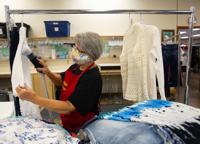
Pat Schlote steams clothing before it is put on the sales floor at the Golden Goose Thrift Shop in Catalina, Ariz., on May 21, 2020.
Tucson gets by during coronavirus pandemic
Updated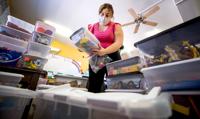
Ada Contreras, teaching assistant, looks through containers while reorganizing toys at Herencia Guadalupana Lab School, 6740 S. in Tucson, Ariz. on May 21, 2020. As Child care centers begin to re-open when they are ready, Herencia Guadalupana Lab School is reorganizing and cleaning everything in the facility before re-opening on June 2. To allow for social distancing and decrease the amount of items children touch, Herencia Guadalupana Lab School has sheds where items will go as well as placing items in containers organized by category.
Tucson gets by during coronavirus pandemic
Updated
Jen Martinez, right, softball coach, teaches Skylar Reilly about hitting during a session at Centerfield Baseball Academy, 5120 S. Julian Dr., in Tucson, Ariz. on May 21, 2020. After re-opening on Monday, Centerfield Baseball Academy has implemented new policies in response to the Coronavirus Pandemic such as wearing masks, cleaning, signage, hand sanitizer and limiting the amount of people inside the facility.
Tucson gets by during coronavirus pandemic
Updated
Karl Bosma, left, and George Cantua, with facilities and maintenance, lay down stickers to mark six-foot separation distance around one of the baggage carousels, part of the efforts at Tucson International Airport to work within the restrictions of COVID19, May 22, 2020, Tucson, Ariz.
Tucson gets by during coronavirus pandemic
Updated
A lone passenger waits for a flight near one of the shuttered restaurants in the B Gates before Memorial Day at Tucson International Airport on May 22, 2020.
Tucson gets by during coronavirus pandemic
Updated
Drew Cooper on the stage in the St. Philip's Plaza courtyard, May 22, 2020, Tucson, Ariz., where live music is back on the schedule.
Tucson gets by during coronavirus pandemic
Updated
Many people visit Tumamoc Hill during the first day of Tumamoc's re-opening in Tucson, Ariz. on May 25, 2020. After being closed due to the Coronavirus pandemic, Tumamoc Hill re-opened with some modifications. There are hand sanitizer stations throughout the hike to the top as well as arrows, spaced 10-ft apart, lined up and down the hill. Some runners, hikers and walkers are also wearing masks during their hike. "The steps we are taking aim to provide our community with needed exercise, connection to our beautiful desert and a sense of comfort in such a trying time, while balancing the fact that gathering as a community endangers each of us and our loved ones. This is an unprecedented challenge that we are taking extremely seriously," said Benjamin T. Wilder, director of Tumamoc Hill. Visitors are also asked to limit their group to three people and to not touch the gate at the top of the hill- a tradition for some who make it to the top. "This is a time when we need to establish new traditions and adapt in a creative manner that embraces empathy, unity, care and patience," Wilder said.
Tucson gets by during coronavirus pandemic
Updated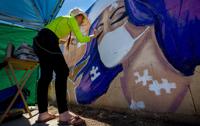
Pen Macias, artist, works on part 2 of a mural for a client on E. Broadway Rd., between S. Columbus Blvd. and S. Alvernon Way, in Tucson, Ariz. on May 25, 2020. Macias, known as The Desert Pen, has been working on her clients mural for the past three months. "It's the one thing I love, I have a passion for and the only thing I could be happy doing," said Macias. The mural represents her client, a single mother of four who works in the health care field. One half of the mural is dedicated to the connection between mothers and their children. The other half is dedicated to the connection between nurses and patients. The client wanted some positivity in the mural to show how nurses give a piece of themselves to their patients hence the puzzle pieces in the nurse and the patients, said Macias.
Tucson gets by during coronavirus pandemic
Updated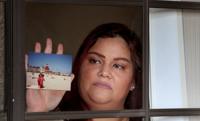
Christina Cortinas, posing at her home, May 28, 2020, Tucson, Ariz., with a photo of her and her mother, Catherine Rodriguez, in San Diego, 1991. Rodriguez is currently in assisted living and fighting COVID19. Cortinas hasn't seen her mother in months, the longest such span in her life.
Tucson gets by during coronavirus pandemic
Updated
Ruben Lopez looks through handouts while attending a Eviction Resource Fair with his family outside the Pima County Justice Court.



